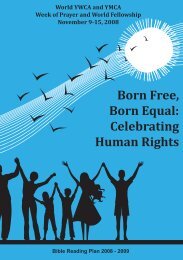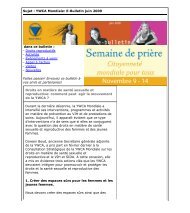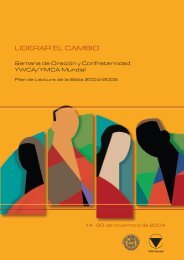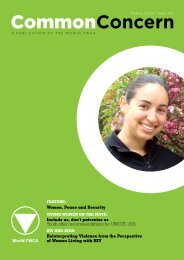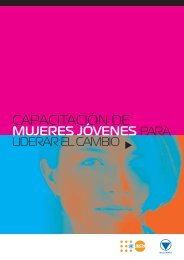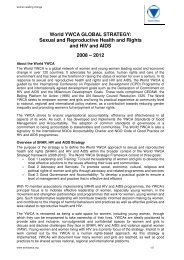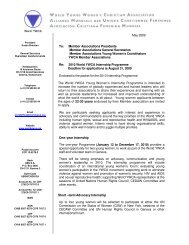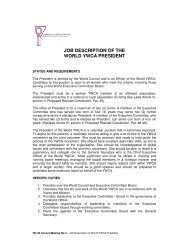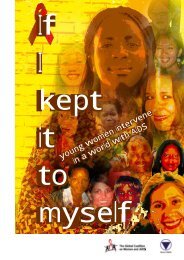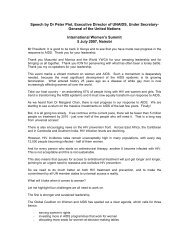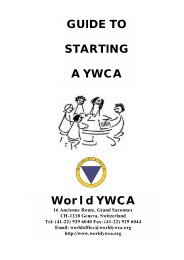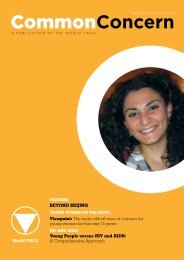World YWCA Let s talk about sex.pdf
World YWCA Let s talk about sex.pdf
World YWCA Let s talk about sex.pdf
You also want an ePaper? Increase the reach of your titles
YUMPU automatically turns print PDFs into web optimized ePapers that Google loves.
CC 20<br />
HIV and AIDS<br />
HIV positive women from around the world face many SRHR violations that include<br />
forced and coerced sterilisation, refusal to provide services, hostile attitudes towards<br />
HIV positive women who seek to have children, stigmatisation at hospitals by hospital<br />
staff, breaches of confidentiality, and testing for HIV without informed consent.<br />
Although many health professionals may not openly<br />
voice such opinions, research studies and anecdotal reports<br />
indicate that such attitudes are widespread. 5 The High<br />
Commissioner for Human Rights (OHCHR) and UNAIDS<br />
have expressly addressed this problem of coercion. In a<br />
1998 statement, OHCHR noted that programmes targeting<br />
pregnant women “often emphasise coercive measures<br />
directed towards the risk of transmitting HIV to the foetus,<br />
such as mandatory testing followed by coerced abortion or<br />
sterilisation. 6 ”<br />
While attitudes have slightly shifted since the introduction<br />
and greater availability of anti-retroviral therapy, too few HIV<br />
positive pregnant women are able to access the treatment<br />
and services they require. In many cases, providers do not<br />
perceive their advice as coercive but instead as providing<br />
‘counseling and guidance’ to women who face many<br />
challenges in the bearing and raising of children as a<br />
consequence of their HIV positive status.<br />
A human rights approach to free and informed<br />
reproductive health decision-making is guided by the<br />
principle that all women have a right to reproductive<br />
autonomy including the right to bear children, regardless<br />
of their HIV status. The Convention on the Elimination of<br />
Discrimination against Women 7 [CEDAW], for example,<br />
provides that women’s human rights are violated by the<br />
failure to both ensure non-discriminatory access to health<br />
services and to protect women from non-consensual<br />
medical interventions. Rather, women are entitled by right<br />
to acceptable healthcare services defined as ”… those that<br />
are delivered in a way that ensures that a woman gives her<br />
fully informed consent, respects her dignity, guarantees<br />
her confidentiality and is sensitive to her needs and<br />
perspectives. 8 ”<br />
Coercive (or non-consensual) medical interventions,<br />
including abortion and sterilisation, constitute grave<br />
violations of women’s human rights as guaranteed not<br />
only in CEDAW, but also the International Covenant on<br />
Civil and Political Rights (the Political Covenant) 9 , and the<br />
International Covenant on Economic, Social and Cultural<br />
Rights (the Economic Covenant). 10 The violation of women’s<br />
human rights to acceptable reproductive health care also<br />
undermines broader public health goals by dissuading<br />
women from seeking care and services. 11 Women may<br />
be deterred ”…from accessing care, because of the<br />
negative associations of HIV, or because they anticipate<br />
or experience prejudicial behaviour from healthcare<br />
providers. 12 ”<br />
The guarantee of women’s human right to free and<br />
informed reproductive healthcare decision-making is,<br />
thus, essential from both a human rights and a public<br />
health perspective. While a woman’s HIV positive status<br />
may influence her healthcare decision-making, it should<br />
not result in her discriminatory treatment at the hands<br />
of health providers or the health system. Prevention and<br />
other health programmes should provide information and<br />
access to services in a manner that respects the dignity of<br />
women by facilitating their free and informed reproductive<br />
decision-making. In the 1998 Guidelines on HIV/AIDS and<br />
Human Rights, UNAIDS and OHCHR expressly recognised<br />
that ”…[l]aws should…be enacted to ensure women’s<br />
reproductive and <strong>sex</strong>ual rights, including the right of<br />
independent access to reproductive and STD health<br />
information and services and means of contraception,<br />
including safe and legal abortion and the freedom to choose<br />
among these, the right to determine number and spacing of<br />
children. 13 ”<br />
The tension between public health and human rights<br />
approaches in reproductive health decision-making, to the<br />
extent that there is one, usually arises not from a difference<br />
in objectives, but a difference in chosen means to achieve<br />
legitimate public health objectives. Rather than viewing<br />
public health and human rights approaches in starkly<br />
opposing terms, it is more useful and more accurate to<br />
consider how existing tensions in implementation can be<br />
overcome. •<br />
Extract from: ‘Bridging the Gap: Developing a<br />
Human Rights Framework to Address Coerced<br />
Sterilization and Abortion’. ATHENA. 2008<br />
References:<br />
1. UNAIDS, The Global Coalition on Women and AIDS. 2006. Keeping the<br />
Promise: An Agenda for Action on Women and AIDS.<br />
2. See Cohen, J., Kass, N. & Beyrer, C. 2007. ‘Responding to the Global HIV/<br />
AIDS Pandemic: Perspectives from Human Rights and Public Health Ethics’.<br />
3. de Bruyn, M. 2002. Reproductive choice and women living with HIV/AIDS.<br />
Chapel Hill, NC:<br />
4. Ibid, p13.<br />
5. Supra note 3.<br />
6. OHCHR and UNAIDS. 1998. HIV/AIDS and Human Rights<br />
7. Convention on the Elimination of All Forms of Discrimination against<br />
Women. A/Res/34/180<br />
8. Committee on the Elimination of All Forms of Discrimination against Women<br />
(CEDAW). 1999. General Recommendation 24: Women and health. para 22.<br />
9. International Covenant on Civil and Political Rights. A/6316.<br />
10. International Covenant on Economic, Social and Cultural Rights. A/6316.<br />
11. The notion that human rights protection promotes public health is commonly<br />
referred to as the HIV/AIDS paradox. See MacFarlane, S., Racelis,<br />
M. & Muli-Muslime, F. 2000. Specifically, the HIV/AIDS paradox teaches that<br />
behaviour modification is best achieved by protecting the rights of vulnerable<br />
groups.<br />
12. de Bruyn, T. 2002. ‘HIV-Related Stigma and Discrimination: The Epidemic<br />
Continues’. In: Canadian HIV/AIDS Policy & Law Review, 7(1), 8 at 9.<br />
13. OHCHR UNAIDS. 1997. HIV/AIDS and Human Rights: International Guidelines.<br />
Second International Consultation on HIV/AIDS and Human Rights.<br />
HR/PUB/98/1, 20-21.<br />
www.worldywca.org




